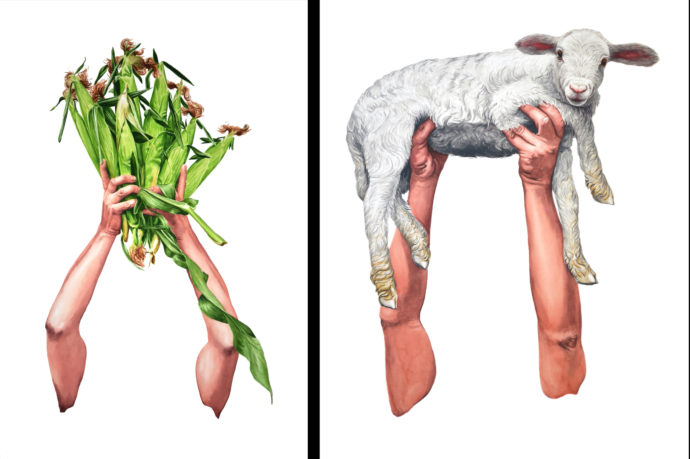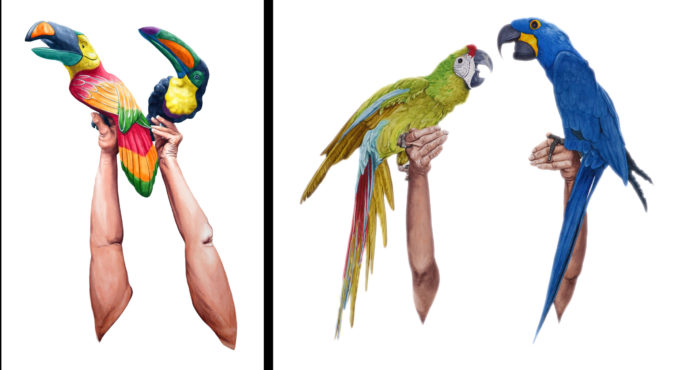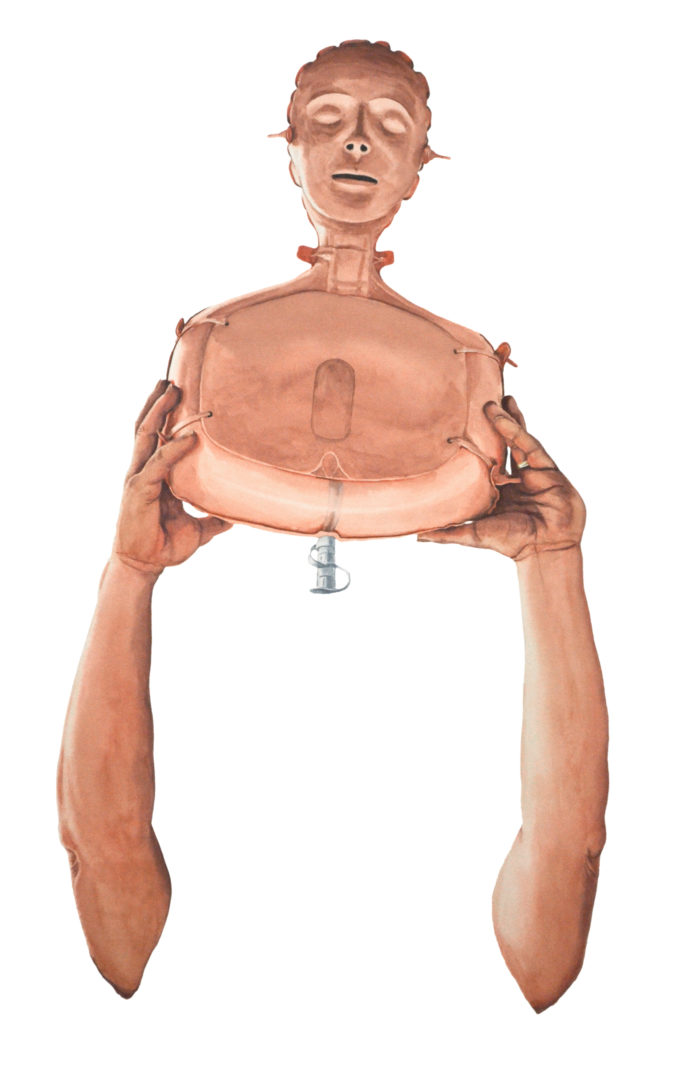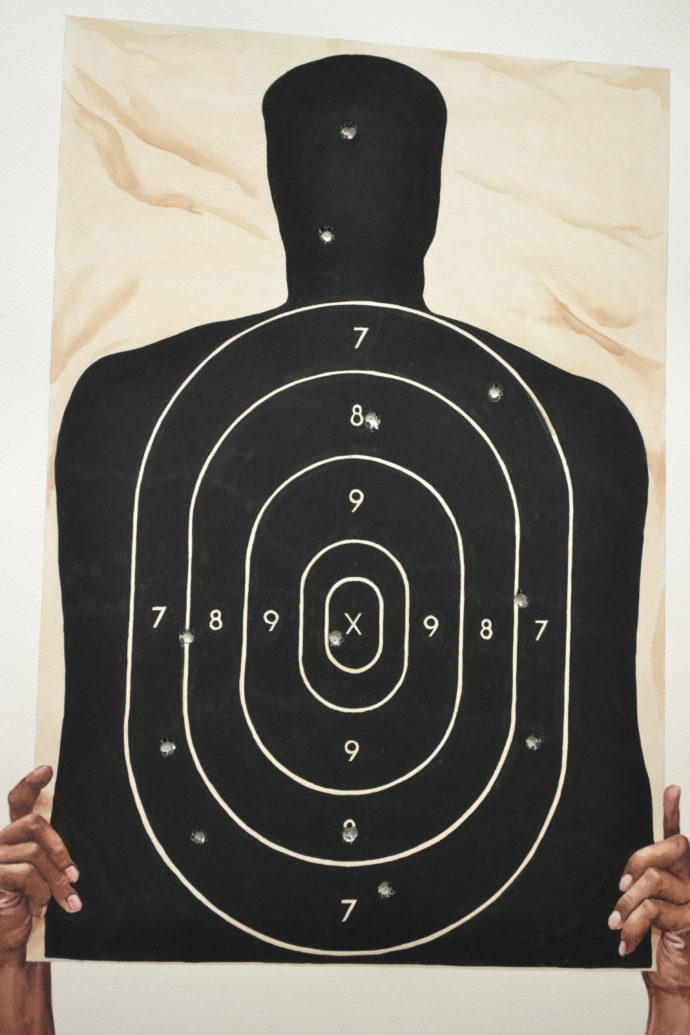UP IN ARMS: AN EVOLUTION
Introduction
When I ran into a roadblock four years ago with my series of paintings and wood engravings devoted to hands–I couldn’t get permission to photograph hand surgeons operating on hands–I literally broadened my interests to encompass arms. Thinking ironically about imagery from the good old U.S.S.R. and its propaganda of heroic posters of working men and women holding up hammers and sickles, I wondered what do Americans value so highly that they would hoist it proudly in the air. As in the hands series, I wouldn’t paint faces. I would only paint the arms and the objects being held aloft. I was interested in the connection between the individual and the object. I would ask a farmers’ market vendor to hold up produce; a parent an infant, a musician an instrument, a mechanic a tool, etc. And not being too shy of puns, I titled the new series: UP IN ARMS.
This essay is not just a listing of the series that now numbers 65 paintings, but I’ll relate how my understanding of the series changed over time and how that understanding affected how I would exhibit the paintings. (For a nearly complete listing of the UP IN ARMS series, please see my portfolio: http://www.scottponemone.com/portfolio/up-in-arms-2/)
First exhibition
Naturally I started with little dogs. As an owner of an 78-pound airedale, I’ve always found little dogs and their owners amusing. What is that squirrel-size thing at the end of a leash? Anyway, picking on little-dog owners walking in the neighborhood with their pet was a way for me to build the gumption to ask strangers to pose for my camera. The experience was heartening. About half of those folks I asked agreed to hold their little pup above their head. I always presented my models with my business card, saying contact me if you want a photos of yourself modelling for me. No one has ever emailed me afterwords.

(left to right) Pet Lift D, watercolor, 30 July 2013, image 23 1/2″ x 13 1/2″; Pet Lift B, watercolor, 19 July 2013, image 26 1/2″ x 17 1/2″; Pet Lift C, watercolor, 24 July 2013, image 24 1/2″ x 13 1/2″
Above are three of the first four UP IN ARMS paintings. Each was painted on a sheet of Arches cold press watercolor paper measuring about 35″ x 25″. The cat painting–of me holding up Oscar–if nothing else demonstrates that cats don’t like being taken out of their comfort zone while dogs just might enjoy the view.

RAISING CORN, watercolor, 7 August 2013, image 25 3/8″ x 15 1/2″; MEAT:LAMB, watercolor, 4 Sept. 2013, 22 3/4″ x 17 3/4″
With my confidence raised by pet owners, my next source of models was found at the local farmers’ market. I approached a corn seller with the age-old question: How many ears of corn can you hold above your head at one time? There was no hesitation to find out.
Then came chard, watermelon and eggplant. My first foray into livestock came when I asked a friend who’s a commercial photographer and happens to raise sheep on his Harford County farm if I could visit him during lambing season.

KW-Caught II (Tuna), watercolor, 21 Oct. 2013, image 21 1/2″ x 23 1/4″; KW-Caught I (Barracuda), watercolor, 16 Oct. 2013, 17″ x 28″
I used images of these early UP IN ARMS paintings in applying for a residency at The Studios of Key West. I said I would go down to the charter boat dock and ask tourists/fishermen to hold up their prized catch. The Studios of Key West took the bait. And as you can see from the images above, so did the fishermen.

KW-Fake I (Paper maché toucans), watercolor, 12 Oct. 2013, image 27″ x 17 1/4″; KW-Feathers I, watercolor, 25 Oct. 2013, 21″ x 22 3/4″
But the best part of Key West is not the tourists, but the locals. If you think Baltimore can breed some oddball types, imagine what tropical heat can do to the brain. The paper machè toucans were sitting in one of several huge wire cages outside a house not far from the residency. I biked passed several days before I came across an elderly husband and wife were doing yard work there. I asked the gentleman where are your birds. He said neighbors complained about the noise they made; so they’re now inside. The fake toucans were the only outdoor cage occupants. Upon request, the wife modeled them for me. The real macaws lived at Nancy’s Secret Garden. A small sign by the sidewalk of a rather ramshackle wood-frame Victorian house led you to a gate and buzzer beside the house. Nancy with her long grey hair in a ponytail and her black t-shirt with human skulls soon answered. She led me to her backyard populated with large wire cages. While she normally charges to bring out her macaws, as a fellow artiste she modeled them for me gratis.

Python Fore, watercolor, 5 Aug. 2016, image 21 1/2 x 44 1/2′; Python Aft, watercolor, 5 Aug. 2016, image 25 1/2″ x 44 1/2″
And then there was the zoo underneath the Monroe County Detention Center. One Sunday a month there was an open house. Jeanne, the woman who ran the place, had a year-old sloth draped around her neck. The rest of the zookeepers wore jail-issued orange jumpsuits. After they held up an African tortoise, rabbits, the sloth, a kinkajou, and a large lizard, I asked: What about the albino python curled up in its cage? Did they ever take it out? Yes, I was told, to feed it. So the next Wednesday I returned (they wouldn’t take it out during the open house with swallow-size children running about), and the python was held aloft by Jeanne and three inmates.
Note that the date on those two paintings is nearly three years later than the other Key West paintings. The logistics of this image were daunting. Do I paint the snake as an albino and struggle with making it jump out from the white paper? Do I paint four separate paintings, one for each holder? I finally decided to 1) yes, keep it albino and 2) paint it on two pieces of paper–each 35″ x 52″–cut from a 10-foot roll of paper. I kept the scale the same so that, should I decide to, I could cut the right margin off the Fore painting so that the two images would fit together. (See the photoshopped image that leads this post.) However, I don’t intend to.
The Key West residency did lead to my first exhibition of UP IN ARMS paintings. And it was a disaster. At a carnival there I met a potter of playful ceramics. He offered to exhibit my works in his showroom in early 2014. I agreed to frame four paintings and send four others with just a foamboard backing. Well the frames got damaged in shipping. So I had to have a Key West framer repair them. Nothing sold. Then I had all eight shipped back without frames.
SEcond Exhibition
By the time of the second UP IN ARMS exhibition in November 2015, I had 48 paintings to choose from. I had added six paintings of naked infants held by a parent, four of critters both domestic and wild, three of food both baked and raw, two of music, five of plastic, one of a tire, one of a chain saw and one of a CPR dummy.
One way I could exhibit them would be in single file, marching around a gallery with no sense of order, just one image after another, independent of each other yet somehow in conversation with adjacent paintings. Then I conceived of the notion of Triplets, groups of three that are arbitrarily arranged as if appearing randomly at a slot machine window. This is what I wrote in an artist statement for an exhibition competition in 2015:
I believe the paintings can be quite powerful individually. Yet I always suspected that a dialog would occur between paintings once they are presented formally in a gallery. But not until recently did I realize how magical groupings of UP IN ARMS paintings would be. And groups of threes–Triplets–seem to work best. The selection and order within the groups are very interchangeable, and each variation instantly creates a new dynamic, a different energy, a change in tension.
My first chance to display UP IN ARMS paintings in Triplets came at Jordan Faye Contemporary in Baltimore in November 2015.

Jordan Faye Block, director of Jordan Faye Contemporary in Baltimore, ponders Triplets of UP IN ARM paintings before mounting them on the wall.

(left Triplet) ABoy, watercolor, 10 Sept. 2014, image 27 1/2″ x 16″; MEAT:PORK, watercolor, 16 Sept. 2013, image 20 1/4″ x 19 1/2″; HBoyButt, watercolor, 25 Sept. 2014, image 28″ x 16 1/2″. (Right Triplet) TOOLBOX, watercolor, 23 July 2015, image 29 1/2″ x 20 1/4″; ONE FOR THE ROAD, watercolor, 30 Dec. 2014, image 26 1/2″ x 16″; RAISING EGGPLANT, watercolor, 28 Aug. 2013, image 24″ x 15 7/8″
As you can see, none of the paintings in this gallery space were framed. (Unfortunately these Triplets were only hung for the opening. The space was later used for a holiday bazaar.) I presented most of the paintings in this exhibition unframed to maximize the interaction between the images of each Triplets.

KW-Caught III, watercolor, 20 Feb. 2014, image 29 1/4″ x 9 7/8″; BBoyButt, watercolor, 3 Oct. 2014, image 25 3/5″ x 21 1/2″; Horn, watercolor, 29 Nov. 2014, image 27″ x 18 3/8″
Above is a Triplet with frames, while below are two Triplets unframed in the same gallery.

(Left Triplet) KW-Fake I, watercolor, 12 Oct. 2013, image 27″ x 17 1/4″; MEAT:GOAT, watercolor, 16 April 2015, image 28″ x 16 1/4″; LOAVES, watercolor, 15 July 2015, image 25 1/4″ x 20 1/4″. (Right Triplet) RAISING HEADS, watercolor, 22 May 2014, image 28″ x 19 3/8″; SAW, watercolor, 17 Sept. 2015, image 30 3/8″ x 15 1/4″; WARTY GOURDS, watercolor, 2 April 2015, image 28 1/4″ x 15 3/4″
While I’m thankful that Jordan Faye Contemporary gave me this exhibition, I was disappointed that most of my show was presented in a rather small, disjointed space that both limited the number of Triplets on display and didn’t provide optimal viewing distances to see individual triplets as well as to see the variations in the Triplets.
THIRD EXHIBITION
In 2016 I started to create groupings of related objects. In reaction to the uprising in Baltimore after the death of Freddie Grey, I tried to get images of objects related to police and gun violence. Going through formal channels at the city Police Department went nowhere not surprisingly. Going to the downtown shop that provided tools of the trade to law enforcement officers also was a waste of time. Ditto at gun shops. I even went to an outdoor target range in Baltimore County. The good old boys who ran the place were immediately suspicious of my request for folks to model their weapons. They offered to bring up my request at the club’s board meeting, but I knew not to expect a positive result.

FF CPR, watercolor, 11 Sept. 2015, image 29″ x 16 1/4″
So until I figured out how to approach weapons use in Baltimore, I turned to the fire department. I already had a related image painted, thanks to the 2015 Maryland State Fair, where firefighters had a CPR dummy on display. Unlike the Police Department, the Baltimore Fire Department was quite welcoming. One of the huge garage doors was open at the Lombard Street station when I approached in August 2016. No one was about when walked in. The fire trucks stood ready. By each door were uniforms with boots attached, positioned so that firefighters could quickly outfit themselves. Finally I came upon a control room. I explained to the woman on duty there why I was there. She summoned a young firefighter, who was white, to be my model, and he gamely first held up the giant pneumatic wrench called “The Jaws of Life,” then a pair of axes, an oxygen tank with its harness and finally a helmet. I returned a few days later with printouts of some of the resulting photos, but my first model wasn’t there. I asked the pair of black firefighters I met on my second visit to hold up a coil of hose, but they declined, offering instead to summon a muscle-bound firefighter whom they called The Hulk. And The Hulk dutifully arrived by sliding down a brass pole. He effortlessly hoisted a coil of hose. Once again firefighters helped me out. I only wished The Hulk was black so I could represent the racial diversity of the Fire Department.

(from the right) FF HELMET, watercolor, 10 Nov. 2016, image 26 3/4″ x 18 1/2″; FF TANK, watercolor, 29 Nov. 2016, image 26 1/4″ x 15 1/2″; FF CPR; FF HOSE, watercolor, 31 Oct. 2016, image 23″ x 20 1/2″; FF JAWS, watercolor, 30 Sept. 2016, image 24 1/2″ x 21 1/2″
While I was painting the firefighters suite, which I was later to call LIFESAVERS, someone told me about Continental Arms, an indoor pistol range in Timonium, just north of Baltimore. There I watched guys fire their weapons at paper targets. What do they do with the used targets, I asked the woman in charge. Often they throw them away, I was told. She offered to collect some over the weekend. Good to her word, the following Tuesday I picked up about a dozen bullet-ridden targets, most with a black torso and head, a few in magenta. Now I needed models. The paper targets–each about 35″ by 22″–were too flimsy to hold up. So I glued a black target to one side of a piece of foamboard and a magenta target to the other. Then I took the board to the park around the Washington Monument in the Mount Vernon neighborhood in Baltimore. I asked various folks to hold up the target for me to photograph. I told each willing person that you could choose to hold up the black side or the magenta side and that you could hold the target right-side up, upside down or on its side. I found willing models black and white, male and female. This was a new approach for me. Instead of having models hold up an object closely associated with them–most notably a parent and a child–I sought out models based on demographics.
As I was drawing the first Target image, it dawned on me not to paint the bullet holes. Doing so would be a pain. Since I don’t paint white, it would mean painting around each hole in order to leave the hole white. Why not, I asked myself, use my Target paintings for target practice.
As you can see, my request was wholeheartedly accepted at the Timonium pistol range. All that I asked of Lucito “Lou” Lara, the range master, was to fire within the painted image of the targets.

After he shot it, Lou Lara holds up TARGET B.

Above is a closeup of Target B. Now how could painted bullet holes compare to these? Soon all of the Target paintings were violated with pistol holes.
By the end of February 2017 I had seven Target paintings, five with black targets like Target B and two with the colors reversed. I decided against painting magenta targets. There was no metaphoric import to that hue. Instead when models chose to pose with the magenta target, I painted the target tan and the background black (or reverse of the black target paintings). This way I could present paintings where the targets could represent the skin color of victims of gun violence, while the skin color of the models could represent either the victims or the shooters.

(Left to right) TARGET A, watercolor, 5 Jan. 2017, image 33 1/2″ x 16 1/2″; TARGET D, watercolor, 2 Feb. 2017, image 30″ x 23 1/2″; TARGET G, watercolor, 23 Feb. 2017, 34 1/8″ x 17 1/4″; TARGET B, watercolor, 12 Jan. 2017, image 35 1/4″ x 18″; TARGET E, watercolor, 9 Feb. 2017, image 26″ x 16 1/4″; TARGET C, watercolor, 20 Jan. 2017, image 35″ x 15 1/4″; TARGET F, watercolor, 15 Feb. 2017, image 34″ x 16 1/2″
OK, now I had what I hope would be seen as a thought-provoking group of paintings. The only problem was that the curator of my next exhibition didn’t know about this turn in my oeuvre. Last summer I was contacted by the curator of the art gallery at Harford County Community College. He saw images of my paintings at the Baker Artists Awards website. He asked me and a number of other artists to apply for an exhibition in 2017. I provided him with a proposed exhibition of Triplets. The result was an offer of a summer 2017 exhibition at the college.
As I was about to tell the curator about these new paintings and a new way of showing my UP IN ARMS series, I attended a theatrical performance that dealt with racial stereotypes that might be encountered in an upper middle class cocktail party. After the show I stayed for a discussion led by a professor from Morgan State University. As I drove home afterwords, I realized I needed to contact the professor. Would he, I would ask him, be interested in leading a similar discussion during the run of my exhibition in Harford County? The next day I called the theater and got the email address for the professor. I sent him images of groups of paintings for my show.

(top to bottom, left to right) ABoy; HBoyButt; BBoyButt; WBoyButt, watercolor, 22 July 2014, image 29″ x 14 1/4″; BGirl, watercolor, 19 March 2015, image 25 1/4″ x 17 5/8″; WBoy, watercolor, 7 Aug. 2014, image 26 1/2″ x 13 1/2″
His reply was generally positive, but he had this reaction to the above grouping of paintings that I call TABULA RASA;
What immediately struck me about the artwork below is the presence of genital organs of white boys (2) and a black girl (1) and the absence of a similar display of white females and black males. Is this deliberate or is it part of the entire exhibition? I mention this because the most common rape of women in American history is that of the white male raping the black female and the most forbidden relationship was of course, between the white female and the black male. Just curious about this.
This is exactly why a discussion would be needed for this exhibition. His comments are perfectly appropriate; however, my selection of paintings entirely depended upon what side of the child the parent was willing to show the camera. Thoughts of potential rapists and victims were furthest from my mind. These infants–all younger than six months–were selected to illustrate how we each come into this world as a blank slate or tabula rasa. Infants are vessels that will be filled with the language(s) of the parents, the social standing and moral compass of the parents, of siblings, of schoolmates, of friends and extended family.
The professor did visit my studio and thankfully agreed to be available for a discussion during the run of my exhibition. With this promise in hand, I contacted the gallery curator and told him about the professor. Then and only then did I send him a schematic of my exhibition using the diagram of the gallery space that he had sent me.

You’ve seen three of the groupings: TARGET, LIFESAVERS and TABULA RASA. The others are PYTHON where I position the pair on either side of a corner, PLASTIC for the common composition of the objects, FOOD with both vegetables and adorable young livestock, MUSIC with an instrument case and two potential ad-lib instruments, and SPARE because that it what it is.
All of the paintings were delivered to the curator last week along with the diagram and instructions for spacing. The paintings will be hung with magnets. The exhibition opens June 2 and closes September 15 with a reception Thursday, September 14. I’ll be out of the country until just before the opening.
Even though I would have preferred not showing over the summer, this exhibition has given me an opportunity to display UP IN ARMS paintings to reflect how I currently think of them–an evolution that has gone from seeing them as individual paintings, to members of arbitrary Triplets, to groupings of like-minded paintings.
INSTALLATION at Harford CC
I haven’t been to the show yet, but it was installed according to my instructions that I sent before I left for Italy on May 1, 2017. I hope to view the show and maybe update these images. The reception is not until mid-September. Curator Brad Blair kindly sent me these images.

TARGETS with LIFESAVERS (left)

PYTHON, FORE and AFT

BABIES, INSTRUMENTS & SPARE

FOOD and PLASTIC
Trackback URL: https://www.scottponemone.com/up-in-arms-an-evolution/trackback/











What a journey. These are great Scott. The commentary about genitalia is interesting to think about…I just see cute wrinkly naked babies though.